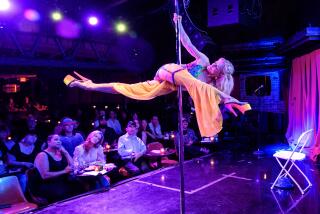Pole dance as art form
Sergia Anderson climbed high up a pole as Bjork’s “Hyperballad” blasted through Circus Disco, a West Hollywood nightclub. Spinning and twirling, legs straight and toes pointed, she hung perpendicular to the ceiling, holding the pole with just her hands. Anderson then dropped quickly, catching herself just inches above the floor.
The crowd gasped, then applauded.
So goes the National Aerial Pole Art Championship, in which 10 amateur pole dancers and 16 professionals competed on April 7. The stage included two floor-to-ceiling poles -- one that spun and one static -- against a glittery backdrop for competitors. Receiving the biggest applause was Greta Pontarelli, a 62-year-old amateur competitor, as she held herself, still and taut, upside down on the static pole.
Anderson, a 30-year-old competitor and owner of the Vertitude pole fitness studio in Canoga Park, began dancing when she was 4, but it wasn’t until she discovered pole at 27 that she found an art that spoke to her.
What was once a dance that was synonymous with strip clubs, pole art has become an underground community that is finding its way into mainstream dance, fitness, art and culture.
“There is a stigma attached to pole, but in the last one to three years, we’ve seen an extreme spike in pole dancers,” said Annemarie Davies, founder and chief executive of United Pole Artists, a Web-based news source for pole dancers.
There are about 500 pole studios in the U.S., about three times as many as five years ago, she said.
Pole dancing even got a shout-out on Martha Stewart’s television show, when the then-68-year-old host shook her hips and twirled around a pole with her energetic and much younger teacher.
Anderson, who placed second in her division in the national competition, said she never intended to compete in pole art. Unlike in ballroom, ballet and jazz, where her goals were to be the best, the improvisational and creative movement of pole dancing simply made her feel good.
“The floor-to-pole transitions really excite me as a choreographer,” she said. “It’s like being a kid on a playground.”
“These women are not just strippers or gymnasts,” said Nadia Sharif, a former electrical engineer who won the National Aerial Pole Art Championship in 2012. “So many women from the professional world, lawyers and doctors, people who are young and old, participate.”
The director of the event, a woman who goes by Anjel Dust, organized her first competition in 2006, the California Pole Dance Championship. At that time, there were very few competitions or even performance opportunities for pole artists outside of strip clubs, she said.
“There comes an age where you can’t be a competitive gymnast or ballerina anymore,” Dust said. “Unfortunately, they are washed up in those professions at a considerably young age. Many of these people are finding pole dance to be a place they can excel.
“They find another activity where they can use their strength, creativity and flexibility to their advantage. In turn, they are helping bring the pole dance to a higher level artistically.”
That’s not to say a person needs a dance or gymnastic background, Dust said. “Some people who have risen to the top have no previous formal training.”
Consider Sharif, who installed a pole in her room and learned the art by watching YouTube videos. She entered her first competition in 2008 and has been teaching since 2009. She was a judge at this year’s National Aerial Pole Art Championship.
“From my posture and body awareness, I have gained so much confidence,” said Sharif. “I can’t picture my life without pole dancing now.”
In routines, some competitors mimic circus aerial performances, while others are clearly former gymnasts, said Sharif. Some go the “sexual route,” but Sharif said she looks for a well-rounded performance of strength, flexibility, grace, power, agility and emotional impact.
Sharif said pole art got her out of a cubicle, and she now travels the world teaching and performing.
“Pole dance might be far from being fully accepted by the mainstream, but we are converting enough people day by day to be one of the fastest growing new forms of dance,” said Dust. “Pole fitness studios are popping up on every other corner.”
“Hey,” she continued. “If ... Martha Stewart can give it try, maybe everybody should.”
--
--
(BEGIN TEXT OF INFOBOX)
--
First Time around
For those who want to give pole dancing a try, studios tend to welcome beginners with open arms, says Annemarie Davies, founder and chief executive of United Pole Artists. Many have introductory and beginner classes.
Scared you don’t have the same strength and flexibility as those who competed in the National Aerial Pole Art Championship? You probably don’t, but Davies said that’s no problem.
There are no strength expectations for beginners, Davies said. Men and women will build strength and improve as they move forward in pole, “just like almost everything else in life.”
Nevertheless, a new student should expect to feel sore after the first few classes, likely working muscles never used before.
“A beginner student should expect to feel accepted no matter what size, shape or gender,” she said. “Pole dancing can look easy sometimes, and a lot of people realize very quickly that it is actually quite hard, but not impossible by any means.”
Davies recommended Evolve Dance Studio and Be Spun as studios that are particularly open to beginners.
Evolve Dance Studio in Los Angeles offers a single class for $25 and a package of five for newcomers for $50. evolvedancestudio.com/
Be Spun in Hollywood offers a single class for $35 and various discounted packages. bespun.com/
--
Mikaela Conley
More to Read
The biggest entertainment stories
Get our big stories about Hollywood, film, television, music, arts, culture and more right in your inbox as soon as they publish.
You may occasionally receive promotional content from the Los Angeles Times.










